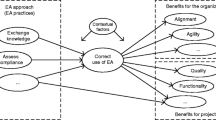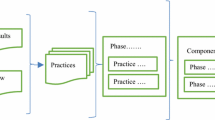Abstract
A high percentage of information system projects still fails due to poor implementation of requirements. Over the years, investigations by numerous scientists suggest that architecture principles are important in the successful implementation of those information systems requirements. However, these investigations are of a theoretical nature; until now, no validation in practice has taken place. Our research stresses this empirical validation: do architecture principles work in real-life situations? To find this evidence, we need an instrument to measure architecture principles, in order to establish the connection between principle and project success. The focus of this paper is such an architecture principle measurement instrument. We describe the results of a literature study, yielding both the definition and the characteristics of the architecture principle. Besides the measurement instrument, we describe the related measurement method, including the test in a real-life case. Based on the outcome of the case study, we extend the instrument with additional architecture principles characteristics and attributes, and we improve the measurement method.
Access this chapter
Tax calculation will be finalised at checkout
Purchases are for personal use only
Similar content being viewed by others
Notes
- 1.
An information system is an system to collect, process, store, and distribute information and includes software, hardware, data, people, and procedures.
- 2.
Definition is an exact statement of the meaning of a subject and description is a listing of all characteristics of a subject [46].
References
Johnson, J., Mulder, H.: CHAOS chronicles, focusing on failures and possible improvements in IT projects. In: 10th International Multi-Conference on Society, Cybernetics and Informatics, IMSCI 2016, July 2016
Borgers, M.A.C.: Do IT architecture principles contribute to IT system’ s requirements realisation? In: DCEIS 2016 - Doctoral Consortium on Enterprise Information Systems, pp. 3–8 (2016)
Borgers, M., Harmsen, F.: Strengthen the architecture principle definition and its characteristics: a survey encompassing 27 years of architecture principle literature. In: ICEIS 2018 - Proceedings of the 20th International Conference on Enterprise Information Systems, vol. 2 (2018)
Borgers, M., Harmsen, F.: Measuring architecture principles and their sets in practice. In: ICEIS 2019 - Proceedings of the 21th International Conference on Enterprise Information Systems, vol. 1 (2019)
Steenhuis, J., De Bruijn, E.: Building theories from case study research: the progressive case study. J. Chem. Inf. Model. 53(9), 1689–1699 (2004)
Eisenhardt, K.M.: Building theories from case study research. Acad. Manag. Rev. 14(4), 532–550 (1989)
Yin, R.: Case Study Research: Design and Methods. Sage Publications, Beverly Hills (1984)
Webster, J., Watson, R.T.: Analyzing the past to prepare for the future: writing a literature review. MIS Q. 26(2), xiii–xxiii (2002)
Stelzer, D.: Enterprise architecture principles: literature review and research directions. In: Dan, A., Gittler, F., Toumani, F. (eds.) ICSOC/ServiceWave -2009. LNCS, vol. 6275, pp. 12–21. Springer, Heidelberg (2010). https://doi.org/10.1007/978-3-642-16132-2_2
Haki, M.K., Legner, C.: New avenues for theoretical contributions in enterprise architecture principles - a literature review. In: Aier, S., Ekstedt, M., Matthes, F., Proper, E., Sanz, Jorge L. (eds.) PRET/TEAR -2012. LNBIP, vol. 131, pp. 182–197. Springer, Heidelberg (2012). https://doi.org/10.1007/978-3-642-34163-2_11
Chrisholm, W., Milic, L.T., Greppin, J.A.C.: Interrogativity. John Benjamins Publishing, Amsterdam (1982)
Fischer, C., Winter, R., Aier, S.: What is an enterprise architecture principle? In: Lee, R. (ed.) Computer and Information Science 2010. Studies in Computational Intelligence, vol. 317, pp. 193–205. Springer, Heidelberg (2010). https://doi.org/10.1007/978-3-642-15405-8_16
Aier, S., Fisher, C., Winter, R.: Construction and evaluation of a meta-model for enterprise architecture design principles. In: 10th International Conference on Wirtschaftsinformatik, Zurich, Switz, 16th–18th February 2011, pp. 637–644 (2011)
Yin, R.K.: The case study crisis: some answers. Adm. Sci. Q. 26(1), 58–65 (1981)
Strauss, A.L.: Qualitative Analysis for Social Scientist. Cambridge University Press, Cambridge (1987)
Miles, M., Huberman, A.M.: Drawing valid meaning from qualitative data: toward a shared craft. Educ. Res. 13(5), 20–30 (1984)
Gersick, C.: Time and transition in work teams: towards a new model of group development. Acad. Manag. J. 31, 9–41 (1988)
Harris, S.G., Sutton, R.I.: Functions of parting ceremonies in dying organizations. Acad. Manag. J. 29(1), 5–30 (1986)
Eisenhardt, K., Bourgeois, L.J.: Politics of strategic decision making in high velocity environments: toward a mid-range theory. Acad. Manag. J. 31, 737–770 (1988)
Babbie, E.: The Practice of Social Research. Cengage Learning, Inc., Boston (2015)
Land, M.O., Proper, E., Waage, M., Cloo, J., Steghuis, C.: Enterprise architecture: creating value by informed governance (2008)
Greefhorst, D., Proper, E., Plataniotis, G.: The Dutch state of the practice of architecture principles. J. Enterp. Arch., 6 (2013)
Winter, R., Aier, S.: How are enterprise architecture design principles used? In: Proceedings of the IEEE International Enterprise Distributed Object Computing Conference Workshops EDOC, September 2016, pp. 314–321 (2011)
Haki, M.K., Legner, C.: Enterprise architecture principles in research and practice: insights from an exploratory analysis. In: Ecis, no. 2013, pp. 1–12 (2013)
The Open Group: TOGAF® Version 9.1. Van Haren Publishing (2011)
Greefhorst, D., Proper, E.: Architecture Principles: The Cornerstones of Enterprise Architecture, vol. 6, no. 3. Springer, Heidelberg (2011)
Hoogervorst, J.: Enterprise architecture: enabling integration, agility and change. Int. J. Coop. Inf. Syst. 13(03), 213–233 (2004)
Lumor, T., Chew, E., Gill, A.Q.: Exploring the role of enterprise architecture in IS-enabled OT: an EA principles perspective. In: Enterprise Distributed Object Computing Workshop (2016)
Slot, R.: A method for valuing architecture-based business transformation and measuring the value of solutions architecture (2010)
Sandkuhl, K., Simon, D., Wißotzki, M., Starke, C.: The nature and a process for development of enterprise architecture principles. In: Abramowicz, W. (ed.) BIS 2015. LNBIP, vol. 208, pp. 260–272. Springer, Cham (2015). https://doi.org/10.1007/978-3-319-19027-3_21
Lindström, Å.: On the syntax and semantics of architectural principles. In: Proceedings of the 39th Hawaii International Conference on System Sciences, vol. 00, no. C, pp. 1–10 (2006)
Borgers, M., Harmsen, F.: Case report of identifying and measuring IT architecture principles in the Dutch tax agency. In: 2016 IEEE 18th Conference on Business Informatics, pp. 100–110, November 2016
Richardson, G.L., Jackson, B.M., Dickson, G.W.: A principles-based enterprise architecture: lessons from Texaco and Star Enterprise. MIS Q. 14(4), 385–403 (1990)
Hoogervorst, J.A.P.: Enterprise governance and enterprise engineering. The Enterprise Engineering Series, p. 428. Springer, Heidelberg (2009). https://doi.org/10.1007/978-3-540-92671-9
Marosin, D., van Zee, M., Ghanavati, S.: Formalizing and modeling enterprise architecture (EA) principles with goal-oriented requirements language (GRL). In: Nurcan, S., Soffer, P., Bajec, M., Eder, J. (eds.) CAiSE 2016. LNCS, vol. 9694, pp. 205–220. Springer, Cham (2016). https://doi.org/10.1007/978-3-319-39696-5_13
van Bommel, P., Hoppenbrouwers, S.J.B.A., Proper, H.A.(Erik), van der Weide, Th.P.: Giving meaning to enterprise architectures. In: Meersman, R., Tari, Z., Herrero, P. (eds.) OTM 2006. LNCS, vol. 4278, pp. 1138–1147. Springer, Heidelberg (2006). https://doi.org/10.1007/11915072_17
Proper, E., Greefhorst, D.: The roles of principles in enterprise architecture. In: Proper, E., Lankhorst, M.M., Schönherr, M., Barjis, J., Overbeek, S. (eds.) TEAR 2010. LNBIP, vol. 70, pp. 57–70. Springer, Heidelberg (2010). https://doi.org/10.1007/978-3-642-16819-2_5
Dietz, J.L.G.: Architecture - Building stategy into design. Academic Service, The Hague (2008)
Marosin, D., Ghanavati, S.: Measuring and managing the design restriction of enterprise architecture (EA) principles on EA models. In: Proceedings of the 8th International Workshop on Requirements Engineering and Law, RELAW 2015, pp. 37–46 (2015)
Zachman, J.A.: A framework for information systems architecture. IBM Syst. J. 26(3), 276–292 (1987)
van’t Wout, J., Waage, M., Hartman, H., Stahlecker, M., Hofman, A.: The Integrated Architecture Framework Explained. Why, What, How. Springer, Heidelberg (2010). https://doi.org/10.1007/978-3-642-11518-9
Land, M.O., Proper, H.: Impact of principles on enterprise engineering. In: Ecis, no. 2007, pp. 1965–1976 (2007)
Marosin, D., Ghanavati, S., Van Der Linden, D.: A principle-based goal-oriented requirements language (GRL) for enterprise architecture. CEUR Workshop Proceedings, vol. 1157 (2014)
Buckl, S., Matthes, F., Roth, S., Schulz, C., Schweda, C.M.: A conceptual framework for enterprise architecture design. In: Proper, E., Lankhorst, M.M., Schönherr, M., Barjis, J., Overbeek, S. (eds.) TEAR 2010. LNBIP, vol. 70, pp. 44–56. Springer, Heidelberg (2010). https://doi.org/10.1007/978-3-642-16819-2_4
Babbie, E.: The Practice of Social Research (2015)
Lyons, J.: Semantics, vol. I. Cambridge University Press, Cambridge (1977)
Acknowledgements
Special thanks to the senior experts Saco Bekius (DTA, now M&I Partners), Martin van den Berg (Dutch Central Bank), Danny Greefhorst (ArchiXL), Paul Oude Luttighuis (Le Blanc Advies) and Raymond Slot (Hogeschool Utrecht) for reviewing (parts of) this paper.
We would like to thank Yvette Hoekstra and Henk van den Berg for participating in the research team of the case study and giving all kinds of comments on both the measurement instrument and the case study results. Secondly, we want to thank the Dutch Tax Agency, and Jelco Bosma specifically, for enabling the case study.
Author information
Authors and Affiliations
Corresponding author
Editor information
Editors and Affiliations
Appendix
Appendix
Rights and permissions
Copyright information
© 2020 Springer Nature Switzerland AG
About this paper
Cite this paper
Borgers, M., Harmsen, F. (2020). An Architecture Principle Measurement Instrument Tested in Real-Life. In: Filipe, J., Śmiałek, M., Brodsky, A., Hammoudi, S. (eds) Enterprise Information Systems. ICEIS 2019. Lecture Notes in Business Information Processing, vol 378. Springer, Cham. https://doi.org/10.1007/978-3-030-40783-4_26
Download citation
DOI: https://doi.org/10.1007/978-3-030-40783-4_26
Published:
Publisher Name: Springer, Cham
Print ISBN: 978-3-030-40782-7
Online ISBN: 978-3-030-40783-4
eBook Packages: Computer ScienceComputer Science (R0)




